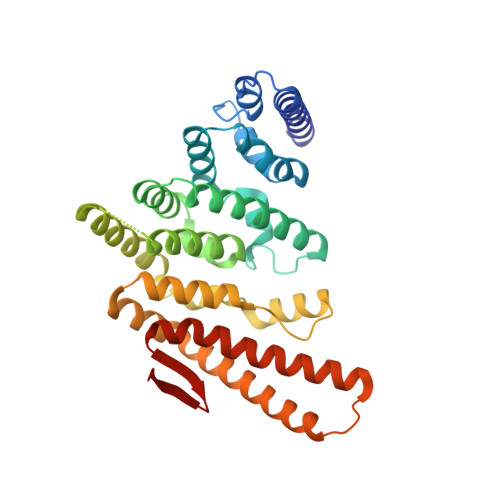The C-terminal domain from S. cerevisiae Pat1 displays two conserved regions involved in decapping factor recruitment.
Fourati, Z., Kolesnikova, O., Back, R., Keller, J., Charenton, C., Taverniti, V., Plesse, C.G., Lazar, N., Durand, D., van Tilbeurgh, H., Seraphin, B., Graille, M.(2014) PLoS One 9: e96828-e96828
- PubMed: 24830408
- DOI: https://doi.org/10.1371/journal.pone.0096828
- Primary Citation of Related Structures:
4OGP, 4OJJ - PubMed Abstract:
Eukaryotic mRNA decay is a highly regulated process allowing cells to rapidly modulate protein production in response to internal and environmental cues. Mature translatable eukaryotic mRNAs are protected from fast and uncontrolled degradation in the cytoplasm by two cis-acting stability determinants: a methylguanosine (m(7)G) cap and a poly(A) tail at their 5' and 3' extremities, respectively. The hydrolysis of the m(7)G cap structure, known as decapping, is performed by the complex composed of the Dcp2 catalytic subunit and its partner Dcp1. The Dcp1-Dcp2 decapping complex has a low intrinsic activity and requires accessory factors to be fully active. Among these factors, Pat1 is considered to be a central scaffolding protein involved in Dcp2 activation but also in inhibition of translation initiation. Here, we present the structural and functional study of the C-terminal domain from S. cerevisiae Pat1 protein. We have identified two conserved and functionally important regions located at both extremities of the domain. The first region is involved in binding to Lsm1-7 complex. The second patch is specific for fungal proteins and is responsible for Pat1 interaction with Edc3. These observations support the plasticity of the protein interaction network involved in mRNA decay and show that evolution has extended the C-terminal alpha-helical domain from fungal Pat1 proteins to generate a new binding platform for protein partners.
- Laboratoire de Biochimie, Centre National de Recherche Scientifique (CNRS) UMR 7654, Ecole Polytechnique, Palaiseau Cedex, France; Institut de Biochimie et Biophysique Moléculaire et Cellulaire (IBBMC), Centre National de Recherche Scientifique (CNRS) UMR 8619, Bat. 430, Université Paris Sud, Orsay Cedex, France.
Organizational Affiliation:


















